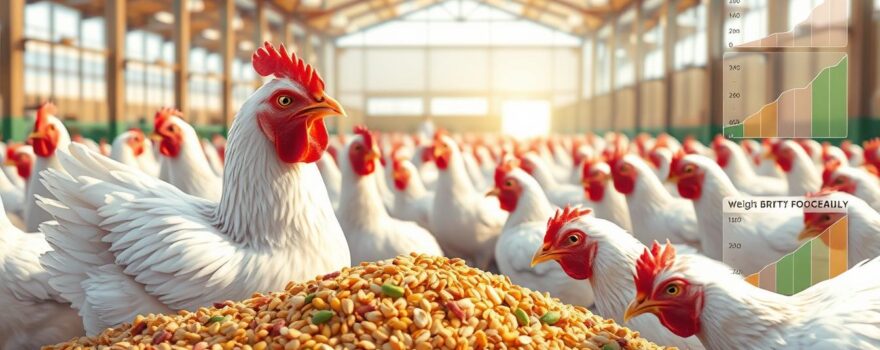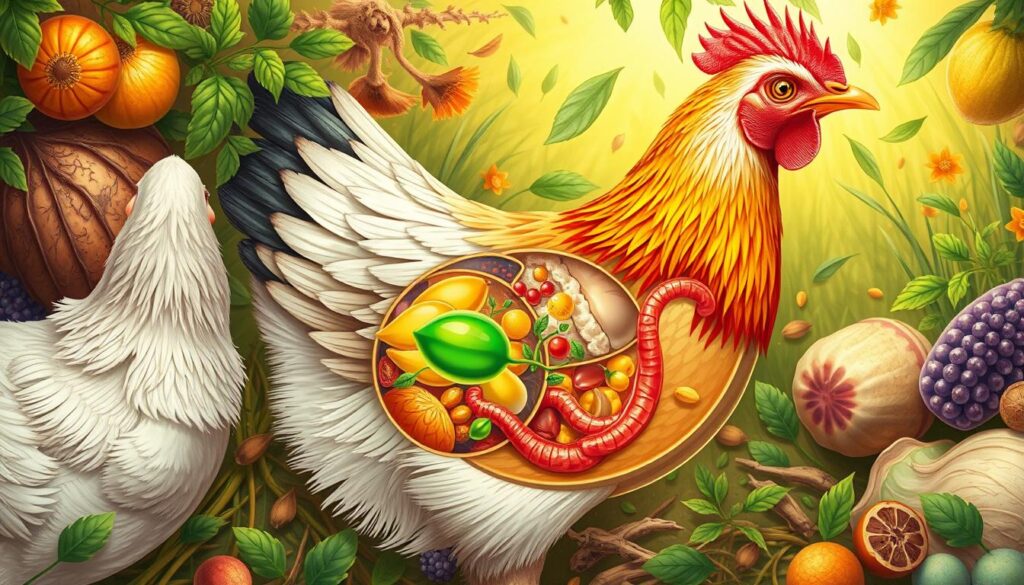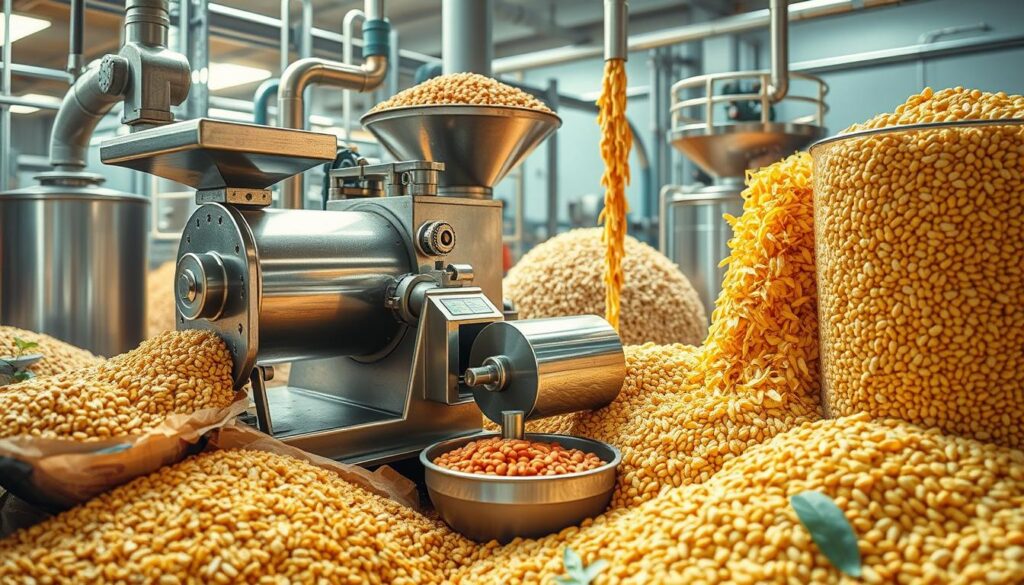
Feed is the biggest cost in raising chickens, making up 70% of expenses. It’s key to use nutrients well to boost feed efficiency. Yet, chickens lose a lot of nutrients in their waste. This includes 30% dry matter, 25% energy, 50% nitrogen, and 55% phosphorus.
These could have helped the chickens grow. To fix this, farmers use special feed processing and microbial enzymes. This helps improve how well the chickens use their food.
Key Takeaways
- Feed is the most expensive input in poultry production, accounting for about 70% of total variable costs.
- Proper nutrient utilization is essential to optimize feed efficiency.
- Broiler chickens excrete a significant amount of nutrients in droppings, indicating the need for improved nutrient absorption.
- Physical feed processing and the use of microbial enzymes can enhance nutrient utilization and broiler performance.
- Understanding the role of digestibility in broiler chicken feed efficiency is crucial for optimizing poultry production.
The Role of Digestibility in Broiler Chicken Feed Efficiency
Nutrient Absorption and Gut Health
Broiler chicken feed efficiency is greatly affected by how well nutrients are digested and absorbed. Grains like maize have phytate and other anti-nutritional factors that block the use of phosphorus and other minerals, amino acids, and starch. Broiler chickens can’t break down these grains well because they lack the enzyme phytase. This leads to poor nutrient absorption and gut health.
Feed Formulation and Anti-Nutritional Factors
To solve these problems, adding a lot of microbial phytase to diets based on grains has helped. Maize-soybean diets also have oligosaccharides and non-starch polysaccharides (NSP) like arabinoxylans, β-glucans, and cellulose. These can make it harder for nutrients to be used. Adding enzymes like xylanase, β-glucanase, and α-galactosidase has been shown to help. It makes digestion better and improves how well the birds do.
| Enzyme | Effect |
|---|---|
| Xylanase | Decreases intestinal viscosity and increases digestibility and performance |
| β-glucanase | Decreases intestinal viscosity and increases digestibility and performance |
| α-galactosidase | Decreases intestinal viscosity and increases digestibility and performance |

“The application of microbial enzymes and pelleting of diets improved energy utilization, amino acid digestibility, and mineral digestibility in broiler chickens.”
Feed Processing Methods and Nutrient Availability
Grinding and pelleting are key in making nutrients more available for broiler chickens. Grinding breaks down cellulose and hemicellulose, making nutrients easier to use. Microbial enzymes also help by reducing anti-nutritional factors, improving digestibility and nutrient use.
Physical Feed Processing and Microbial Enzymes
Pelleted feeds are better than mash diets in quality and performance. Pelleting makes feed more appealing and increases intake. Microbial enzymes in broiler diets break down complex carbs and anti-nutrients, enhancing nutrient availability.
| Parameter | Co-FFM Diet | Control Diet |
|---|---|---|
| Total Body Weight Gain (g/chick) | 2,827 | 2,791 |
| Total Feed Intake (g/chick) | 5,018 | 4,991 |
| European Production Efficiency Factor | 375 | 377 |
| European Broiler Index | 371 | 371 |
| Feed Conversion Ratio (g/g) | 1.77 | 1.78 |
The table shows the benefits of using microbial enzymes in broiler feed. The Co-FFM diet had better weight gain, feed intake, and feed conversion. This highlights the need for better feed processing to improve broiler performance.

“The transition of the digestive system to exogenous nutrition in post-hatch birds is a critical phase in their development.”
Microbial Enzymes in Broiler Diets
Microbial enzymes are key in modern broiler diets. They help improve how nutrients are used and boost broiler health. Important enzymes include phytase, xylanase, and β-glucanase.
Phytase is great at making phosphorus from plants more available. It does this by breaking down phytic acid. This makes phosphorus easier for broilers to use and cuts down on waste.
Xylanase and β-glucanase work well in diets with lots of grains. They break down tough carbs, making nutrients more accessible. This helps broilers grow better.
Research shows adding enzymes to broiler diets is a good move. Kaczmarek et al. (2014) found enzymes like protease and amylase help broiler chickens grow. Amerah et al. (2017) also found that enzymes like xylanase and amylase improve how well broilers digest food.
Using enzymes in corn/soy diets is known to boost broiler chickens performance. Factors like maize hardness and drying methods also play a role (Kaczmarek et al., 2013).
In summary, adding microbial enzymes to broiler diets has many benefits. It improves how nutrients are used, boosts growth, and helps the environment. As the industry grows, using these enzymes will keep being important for better broiler feed.
Impact of Feed Form on Broiler Performance
The form of feed can greatly affect broiler performance. Studies have shown that pelleted and mashed diets have different impacts. The results are quite interesting.
Pelleted vs Mashed Diets
Pelleted feeds offer several benefits over mashed diets. Birds fed pellets tend to grow faster and eat more. This is especially true in the starter and grower phases.
Also, pellets lead to better feed efficiency in the starter phase. This is due to better nutrient digestibility and energy utilization. Pellets also help in improving bone strength in broiler chickens.
The impact of feed form is less in the finisher phase. This means the benefits of pellets are more noticeable in the early stages of growth.
The size of feed particles also matters. Medium or coarse particles in mash diets can lead to better growth. This is compared to fine particles.
In summary, pelleted diets offer a clear advantage in broiler performance, especially in the starter and grower phases. However, the interaction between feed form and particle size is crucial. It helps in optimizing broiler productivity and efficiency.
Corn Particle Size and Feed Efficiency
The size of corn particles in broiler diets is key to feed efficiency and broiler performance. Studies show that chicks fed fine corn grow faster. This is because they eat more and use their food better.
Changing corn from a coarse to a finer size boosts feed efficiency by 15% and 4% at 7 and 19 days, respectively. But, using whole grain or coarse ingredients can lower weight and efficiency, especially early on. This is because young chicks can’t grind large particles well.
Research on 3- to 6-week-old broilers found that bigger corn particles mean less feed intake and efficiency. Birds eating corn of 1,644 μm ate about 180 grams more than those eating 615 μm. Also, those eating larger corn had worse feed conversion ratios at 42 days.
This shows how crucial Corn Particle Size is in making broiler diets better. The right corn size affects how much birds eat, how well they use nutrients, and how their gizzards develop. All these factors impact their growth and productivity.
“Grinding corn from a coarse particle size of 1,290 μm to a finer size of 470 μm improved feed efficiency by 15% and 4% at 7 and 19 days of age, respectively.”
The Importance of Feed Particle Size in Broiler Nutrition
The size of feed particles, especially corn, greatly affects how well broilers digest and use nutrients. Many studies have looked into how Grinding and Gizzard Development affect Feed Efficiency and broiler performance.
| Particle Size (μm) | Feed Intake (g) | Feed Efficiency (FCR) |
|---|---|---|
| 615 | 2,950 | 1.55 |
| 863 | 3,050 | 1.60 |
| 1,644 | 3,130 | 1.68 |
| 2,613 | 3,130 | 1.72 |
These studies highlight the need to optimize Corn Particle Size in broiler diets. This improves Feed Efficiency and overall Broiler Performance. Understanding the link between feed size, nutrient use, and gut development helps poultry producers make better choices. This can lead to more efficient and profitable operations.
Metabolizable Energy and Nutrient Digestibility
Corn is a key part of broiler diets, offering Metabolizable Energy (ME) and vital nutrients. But, the Nutrient Digestibility of corn can change a lot. This affects how well broiler chickens use their feed.
Factors Affecting Metabolizable Energy in Corn
Studies found that the apparent metabolizable energy (AME) in corn can vary by over 470 kcal/kg. The genetic makeup of corn, including non-starch polysaccharides, greatly impacts nutrient availability.
One study with 1,000 Cobb 500 broilers showed that lowering metabolizable energy by 100 kcal/kg harmed growth and carcass quality. But, adding exogenous emulsifiers boosted feed conversion ratio and improved nutrient digestibility.
These results highlight the need to understand how Metabolizable Energy and Nutrient Digestibility in corn diets affect broiler performance. It’s crucial for improving broiler production efficiency.
Amino Acid and Mineral Digestibility
Digesting essential nutrients like amino acids and minerals is key for better broiler feed efficiency. Research shows that Amino Acid Digestibility and Mineral Digestibility are greatly affected by Feed Form and Enzyme Supplementation.
Studies indicate that amino acid digestibility is higher in broilers fed pelleted diets than in those fed mashed diets. Adding microbial enzymes boosts the digestibility of most amino acids, except for serine.
Mineral digestibility, such as calcium, phosphorus, and zinc, also improves in pelleted diets. However, copper and boron digestibility is better in mashed diets. Using xylanase and phytase enzymes together increases the digestibility of phosphorus, potassium, and zinc.
| Nutrient | Digestibility Highest in |
|---|---|
| Amino Acids | Pelleted diets with enzyme supplementation |
| Calcium, Phosphorus, Potassium, Sulfur, Zinc, Iron | Pelleted diets |
| Copper, Boron | Mashed diets |
| Phosphorus, Potassium, Zinc | Diets with phytase enzyme |
| Calcium, Phosphorus, Sulfur, Boron | Diets with xylanase and phytase enzymes |
These results underscore the need to optimize Amino Acid Digestibility and Mineral Digestibility in broiler diets. This can be achieved through the right Feed Form and Enzyme Supplementation. It improves feed efficiency and performance.
Bone Quality and Strength
The health and performance of broiler chickens depend a lot on their bones. Research shows that the type of feed and certain enzymes can greatly affect bone quality and strength.
A study looked into how different feeds and enzymes impact broiler bones. It found that birds on pelleted diets had better bone quality than those on mashed diets. Adding enzymes like phytase and xylanase made bones even stronger.
Pelleted feed breaks down harmful substances, making nutrients like phosphorus and calcium easier to absorb. Enzymes, especially phytase, help use these minerals better for bone building.
| Parameter | Positive Control | Negative Control | Phytase | Multi-strain Probiotic | Saccharomyces cerevisiae | Fumaric Acid |
|---|---|---|---|---|---|---|
| Tibia Ash Content (%) | 45.2a | 42.1b | 46.3a | 44.7a | 45.5a | 44.9a |
| Tibia Breaking Strength (N) | 197.3a | 172.5b | 205.1a | 189.2ab | 195.6a | 191.8ab |
| Calcium Retention (%) | 55.1b | 51.2c | 60.3a | 57.4ab | 58.9a | 56.7ab |
Feed form and enzyme use are key to better bone health in broilers. Using these methods can enhance Bone Quality, Bone Strength, and Broiler Performance.
Dietary Enzymes and Feed Conversion Ratio
Using microbial enzymes like phytase, xylanase, and beta-glucanase in broiler diets can greatly improve how nutrients are digested and used. These dietary enzymes help lower the effects of substances that can block nutrient absorption. This leads to better feed conversion ratio and overall performance in broilers.
Studies have found that adding enzyme mixes, including protease, amylase, and enzymes that break down non-starch polysaccharides, boosts nutrient utilization and growth in broiler chickens. Also, adding exogenous xylanase, amylase, and protease to corn/soy diets improves nutrient digestibility and growth in broilers.
Enzymes are key in breaking down plant cell walls, releasing nutrients that were trapped and not available for absorption. This leads to better feed conversion ratio and improved broiler performance. Adding these enzymes to broiler diets also cuts down on nutrient waste, which is good for both poultry health and the environment.
Even though some studies show mixed results on the impact of enzyme ratios (like xylanase, β-glucanase, pectinase) on body weight gain in broilers, most agree that enzyme technology is vital. It makes feed more nutritious, improving feed conversion ratio and broiler performance.
Conclusion
Boosting broiler feed efficiency is key in today’s poultry farming. Using physical feed processing and adding microbial enzymes to diets helps a lot. These steps make nutrients more available and easier to digest.
By doing this, farmers can see better growth in their birds. This leads to higher profits for their farms. It’s a win-win for everyone involved.
Studies show how important it is to make nutrients more digestible for broilers. Things like feed form and corn size matter a lot. They affect how well birds can use what they eat.
Adding enzymes to feed has been a game-changer. It helps birds use nutrients better. This means they grow faster and stronger, leading to better feed conversion.
The poultry industry is always looking to improve. Making feed more efficient is a big part of that. New research and better feed processing are key to success.
By focusing on these areas, farmers can make their operations more efficient. This also helps the environment and gives consumers better, more affordable chicken.